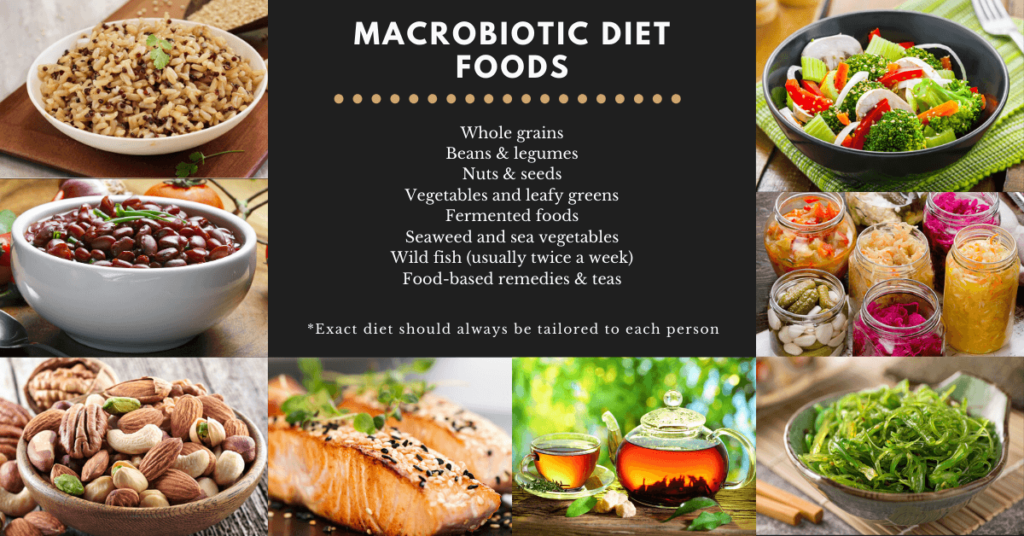 |
Dr. Sommer White, MD Functional Medicine Doctor Macrobiotic Diet Expert |
What is it? | Foods | Plan Overview | Supplements | Lifestyle
The ultimate goal behind the macrobiotic lifestyle is to live a long life free of physical and mental restraints. Unlike many diets that only focus on food, the macrobiotic diet considers not only the food you eat, but also the preparation methods and the impact you have on the planet and the environment. Everything is connected, and as such, the health of the planet influences our health as well.
The macrobiotic diet is a part of a philosophy that offers amazing healing potential to balance your health and life. But is it right for you? In this article, I will share the main principles of macrobiotics including the macrobiotic diet, the health benefits and the common challenges to help you better evaluate it is a good fit for you.
What is The Macrobiotic Diet?
According the macrobiotic community, macrobiotics is a way of life that guides one’s choices in nutrition, activity and lifestyle. It’s a system of principles and practices that promotes harmony between the body, mind and planet.
The word macrobiotic comes from ancient Greek in origin; Makros means large or long, Bios means life, Thike means techniques or art of. Basically, macrobiotic translates to the “art of a long life”.
Macrobiotic Diet: It’s not About Perfection, It’s About Balance
A big part of macrobiotics is learning how certain foods, food preparation methods and lifestyle techniques can bring balance to our individual bodies and minds. As such, the diet is often personalized to help address the individual’s imbalances.
A macrobiotic diagnosis process investigates and finds the root cause of illness by identifying imbalances that lead to disease. Very often two people with the same “condition” have a problem in different organs. As such, they will need a different diet plan that is specifically tailored to address their unique situation.
For example, fatigue may stem from decreased kidney function, sluggish adrenal glands, or poor digestion. The macrobiotic diet prescription focuses on foods that support and restore balance to the impaired organs causing the underlying problem.
For this reason, it is always best to work with a qualified macrobiotic instructor or coach to help you tailor your diet to your unique situation. A trained coach can help you understand the logic behind some of the steps taken to improve your health.
What Should I Eat on the Macrobiotic Diet?
While the exact diet may change from one person to another, it is primarily a plant-based diet that focuses on eating whole local foods that grow in your area. To give you an idea, here are some of the common foods to eat and avoid while on the macrobiotic diet, along with a few important guidelines and principles.
Foods to Eat
- Whole grains
- Beans & legumes
- Nuts & seeds
- Vegetables and leafy greens
- Fermented foods such as high-quality pickles, homemade sauerkraut, short fermented pickles, miso soup
- Seaweed and sea vegetables (usually not local, but are dried so they can be transported easily)
- Condiments rich in minerals: seasonings made from a combination of seaweed, sea salt, and ground nuts and seeds
- Small amount of wild fish (usually twice a week), balanced with vegetables
- Food-based remedies such as: Azuki beans tea (helps to strengthen and heal the kidneys), Umeboshi plum & Kuzu root starch tea (helps to heal the intestinal system).
Foods to Avoid
The macrobiotic diet also eliminates many foods that are not considered nutritious, or known to cause imbalances, these include:
- Processed food
- Simple sugars such as cane sugar, evaporated cane juice, and processed sugars that are stripped of their minerals such as high fructose corn syrup
- Dairy
- “Modern” grains:
Some of the grains available now days are very different from the traditional grains our ancestors used to eat. Those that have been hybridized or genetically modified need to be eliminated to make sure we are getting the highest quality grains that are easy to digest and gentle on our digestive system. - Fruits:
In the last few years, we have widened the macrobiotic diet plan to include more local fruits. Certain local fruits are allowed in moderation. If you live in the United States however, this means you may not be able to eat a lot of tropical fruits such as bananas or papayas, which are imported.
Macrobiotic Diet Plan: Eating Habits & Main Principles
While diet plays a key role in macrobiotics, the approach is much more than just the foods you eat. It also involves how food is prepared and many additional lifestyle considerations. Below are some of the key principles:
Food Preparation
The macrobiotic diet doesn’t only focus on what you eat, but on how you prepare the foods as well. Certain traditional techniques such soaking grains and beans, pressure cooking, making beans with kombu seaweed or salt are used to improve digestion and tolerability.
Take the Time to Prepare and Eat Your Meals
 I think a lot of people in today’s society have stepped away from a natural way of eating. The modern diet is heavily dependent on fast food. We eat while driving or at work in front of the computer or while standing over the kitchen sink. These modern eating habits are extremely destructive for our digestive system.
I think a lot of people in today’s society have stepped away from a natural way of eating. The modern diet is heavily dependent on fast food. We eat while driving or at work in front of the computer or while standing over the kitchen sink. These modern eating habits are extremely destructive for our digestive system.
A big part of healing digestive issues is taking the time to sit down and eat your meals mindfully, to allow your body to properly digest and absorb the nutrients in your food:
- Find a quiet environment you can peacefully eat away from distractions
- Enjoy your food with all your senses, particularly smell and sight, before eating
- Chew your food until it’s liquid in your mouth. That could be anywhere from 30 to 100 times before you swallow, so the foods are in liquid form when they enter your stomach.
Practicing gratitude is one of the major principles of macrobiotics. Before a meal, feel a sense of gratitude towards the food that has been given to you, for the people who have brought the food and for the way the food helps bring balance to your body.
Living in Accordance with Nature
Eat during the day
During the day is when our bodies are most active, which is the time you want to have your meals. When you wake up and eat, you get your metabolism moving, providing your body energy for the day. This is the first step to living in touch with the cycles of nature.
At night, on the other hand, is when our body should be resting and not consuming. You should finish your last meal at least three hours before you go to bed. Ideally, your dinner should be complete by 7:30 pm so you can go to sleep by 10:30 at the latest. This way, your body doesn’t have to deal with digestion while you are trying to sleep. Proper rest will help your body naturally detoxify and restore damage that occurred during the day.
Have your meals the same time at day
 Your body loves routine. Maintaining an eating schedule allows the body to be prepared to stimulate digestion at the same time each day. The time you choose to eat should support your current lifestyle, so you can peacefully eat without distraction.
Your body loves routine. Maintaining an eating schedule allows the body to be prepared to stimulate digestion at the same time each day. The time you choose to eat should support your current lifestyle, so you can peacefully eat without distraction.
Here’s an example:
- Breakfast (between 6:00 am – 8:30 am)
- Lunch (between 11:00 am – 12:30 pm)
- Evening (between 5:00 pm – 7:30 pm)
In case you are wondering where the snacks are, there are usually none!
Constant “grazing” throughout the day can be hard on the liver and digestive system. Snacking between meals forces the body to work extra hard and process food all day, on top of the many different functions it already supports. Not eating between meals allows the liver and digestive system to rest and reset, so they’re ready for the next meal.
On that note, now that you are eating only three meals a day, there’s no need to overeat. Less is more! Overeating taxes the liver and body. Stop eating when you are 70 percent full. It takes time for the brain to receive the signal that you are full, satiation often occur after you complete your meals.
Eat according to season
Depending on the time of the year, you may want to include more raw or cooked foods in your diet. Think about the cold winter months, eating a hot bowl of lentil vegetable soup can help warm and relax the body. So in the winter, we focus on more cooked foods. When it is cold, we don’t include many raw foods due to their cooling effect. Whereas in the summer, we incorporate more fresh raw foods to help cool the body.
With that said, raw foods can exacerbate some conditions such as chronic diarrhea, so on top of the seasonal eating, there are always individual considerations that must be made.
Transitioning to Macrobiotic Diet
As I have mentioned, the macrobiotic diet should be tailored to the individual. This also means transitioning slowly to the diet during the initial stages, allowing your body to adjust.
For example, if you currently do not eat grains or beans, your body may need time to get used to processing and digesting these new foods. This doesn’t happen overnight, so you may want to gradually transition into this type of eating.
Start the plan by combining some of the healthy foods you currently eat that agree with you and benefit your body. Slowly modify the plan to introduce more macrobiotic foods and principles as you adjust.
Supplements and the Macrobiotic Diet
 The current quality of our food may not be the same as when the macrobiotic diet was initially created. We now know that the concentration of vitamins, minerals and other nutrients has declined, and as a result this has affected their healing potential. On top of that, our digestive systems are weaker. We are regularly exposed to chemicals and pesticides that weaken our gut bacteria and this means we can’t process food like we used to.
The current quality of our food may not be the same as when the macrobiotic diet was initially created. We now know that the concentration of vitamins, minerals and other nutrients has declined, and as a result this has affected their healing potential. On top of that, our digestive systems are weaker. We are regularly exposed to chemicals and pesticides that weaken our gut bacteria and this means we can’t process food like we used to.
This unfortunate combination of factors is common and may mean that certain supplements can be valuable part of the healing process. I often see patients with vitamins and mineral deficiencies improve over time with supplement use. While the supplements may vary from one person to another, here are some general recommendations:
- Vitamin B12 especially if you are not eating any animal foods or just eating fish twice a week
- Vitamin D for most people due to inadequate exposure to sunlight or other factors
- Omega 3’s such as fish oil or algae based (vegan) to balance the omega 3 – omega 6 ratios.
Additional Macrobiotics Lifestyle Recommendations

Exercise every day
The type of exercise and intensity depends on the patient’s condition, physical limitations, and fitness level. Some people may benefit from a more vigorous workout while others need a more relaxing routine. The goal is to choose the type of exercise that helps balance your current condition. Generally speaking, most people can start with a brisk walk 30 min a day.
Body rub
Body rub is a practice similar to dry brushing, but gentler. It is designed to open up the pores in your skin, improve circulation and get the lymphatic system moving to promote detoxification. The basic method involves:
- Heat up water in your bathroom sink
- Dip a white unbleached washcloth in the hot water
- Use the washcloth to rub your entire body until skin turns light pink.
Ideally, do the body rub before or after the shower. Some people find it invigorating, others relaxing. Depending on how you feel afterwards, decide if you want to do it in the morning or before bedtime.
Mind-body balance
Macrobiotics believes that your state of mind or mental health is a significant part of the healing process. Focus on feeling moments of gratitude throughout the day, sing a happy song every day to encourage a happy positive outlook to support your wellbeing.
Coffee on the Macrobiotic Diet
 A lot of people are drinking too much coffee these days, more out of habit than anything else. Your morning coffee may have become a ritual you are accustomed to, so you just keep drinking.
A lot of people are drinking too much coffee these days, more out of habit than anything else. Your morning coffee may have become a ritual you are accustomed to, so you just keep drinking.
Just like any food, depending on your individual condition, coffee may benefit you in some ways. But, it can also cause or contribute to imbalances. Coffee can be harmful for certain health conditions such as heart palpitations, breast issues, kidney or bladder weakness, mycotoxin illness and mold exposure. If you constantly have to go to the restroom after drinking coffee, it may not be a good choice for you.
If you like drinking coffee but feel it doesn’t support your health, here are a few healthier alternatives for you to consider:
- Kukicha tea also known as bōcha, the most common macrobiotic tea. It is a mineral-rich tea with a very alkalizing effect in the body and an earthy taste. The tea may have some minimal caffeine in it. If are sensitive to caffeine, start drinking earlier in the day to make sure it won’t affect your sleep.
- Chicory root such as the Teeccino brand that offers a gluten-free version of this coffee substitute.
- Green tea may be helpful for caffeine withdrawal since it does contain a small amount of caffeine.
Final Thoughts
Personally, I have felt the benefits of a macrobiotic diet on my health and think it can be beneficial for most people. It shows us how to become self-aware and evaluate what factors in our life are affecting our health. I have had great success in my medical practices incorporating macrobiotic practices into my patient’s treatment plans.
The macrobiotic diet may offer amazing healing potential to balance your health and life, but at the same time can be very challenging. Food preparation takes a long time, especially in the beginning. In addition, the western diet is heavily dependent on meat. It is so strongly embedded in our culture, this can make it hard for many people to give it up. It may take some time to become used to the different flavors in the macrobiotic diet, particularly those recipes that include sea vegetables.
With that said, macrobiotics is not about perfection, its about balance. We have widened the selection of foods to help people adjust to this type of eating. If plant-based eating is something you find appealing, the macrobiotic diet can be an effective way to get started and minimize the chances of having an unbalanced diet thanks to the focus on nutrient dense mineral rich foods.
As a reminder, it is always best to work with a qualified health practitioner to help you tailor the diet to your unique situation, especially if you have a medical condition. For healthy individuals that want to learn more about the macrobiotic diet, a few good resources are the books Macrobiotics for Dummies, The Hip Chick’s Guide to Macrobiotics and The Complete Macrobiotic Diet.
I hope you find this article helpful in your journey to a better health and well-being.


